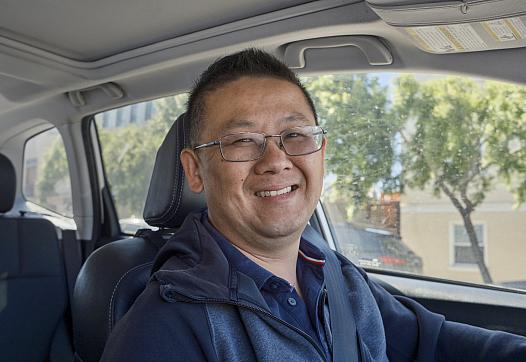Poorly Tracked Virus Is a ‘Silent Killer’ Affecting Asian Americans Most
This story was originally published in the SF Public Press with support from our 2025 California Health Equity Fellowship

Like many people with chronic cases of hepatitis B, contractor Tony Lau didn't realize he had the illness until well into adulthood, even though he was most likely infected at birth.
Jason Winshell/San Francisco Public Press
If it weren’t for his wife suggesting a physical check-up before their wedding, it might have taken years for Tony Lau, a contractor who moved to San Francisco in his teens, to find out he had chronic hepatitis B — a long-term viral infection that can cause liver damage.
“I’m not the type to go see a doctor for no reason,” Lau said.
When Lau was diagnosed at 28, he had been healthy most of his life, seeing doctors only on rare occasions for things like injuries from playing basketball. That’s the tricky part about this illness: It is largely asymptomatic, with fatigue often being the only noticeable sign, making it easy to overlook. This is why experts often call chronic hepatitis B a “silent killer,” even though effective antiviral therapies exist to slow the disease’s progression.
The silence goes beyond symptoms: Hepatitis B is widely misunderstood, a problem worsened by insufficient screening and detection. Chronic hepatitis B isn’t as consistently detected as are acute cases, allowing the disease to frequently progress unchecked and do more damage. According to the World Health Organization, only 13% of those living with the virus know they have it, leaving many, especially in immigrant and marginalized communities, undiagnosed and without access to timely treatment. On top of that, Asian Americans, Pacific Islanders and immigrants from sub-Saharan Africa are significantly overrepresented among chronic hepatitis B patients in the United States, a racial disparity that persists despite decades of advocacy.
A movement to boost data collection and screening for hepatitis B has emerged in the past three years, but progress remains slow due to what advocates say is chronic underfunding. The Trump administration’s recent shutdown of the nation’s largest viral hepatitis testing lab also hinders efforts to test, monitor and fully understand the scale of the disease.
As these efforts languish, patients live with the fallout. If Lau hadn’t gotten screened and treated when he did, he might have joined the 1 in 4 hepatitis B victims who develop irreversible liver damage.
‘Self-perpetuating cycle’
In April, the nation’s leading hepatitis testing lab in Atlanta shut down due to the Trump administration’s workforce cuts at the Department of Health and Human Services. Chari Cohen, president of the Pennsylvania-based Hepatitis B Foundation, warned that this significantly weakens the country’s ability to analyze data and detect viral hepatitis outbreaks. The closure might also hamper efforts to address outbreaks like the recent spike of hepatitis A cases in Los Angeles.
While chronic hepatitis B is a reportable disease, meaning local healthcare providers and laboratories must notify state and local public health departments when they detect an infection, the data collected doesn’t show a comprehensive picture of the disease, Cohen said.
The tracking system for chronic hepatitis B is under-resourced, she said, which hinders analysis and understanding of the disease’s scope. She said research suggests up to 80% of those infected likely remain undiagnosed.
The Centers for Disease Control and Prevention’s Division of Viral Hepatitis relies on data from state and local health departments, but data collection methods vary with local resources. Some jurisdictions collect more detailed information than others. For instance, California, a state with a large Asian and Pacific Islander population and a significant burden of chronic hepatitis B, started only in 2021 to report newly confirmed chronic hepatitis B cases to the CDC on an annual basis.

California’s reporting relies on local health departments to determine whether a case is chronic — a process that often requires staff to dig through records for additional test results or clinical evidence. Confirming a chronic hepatitis B case typically involves analyzing either two types of tests or two results taken at least six months apart. Key details like a patient’s clinical history also can give more insight, but that information is often missing.
The San Francisco Department of Public Health hasn’t published a chronic hepatitis B surveillance report, which offers detailed insight into how the disease affects local communities, since 2016. A spokesperson said a new report is expected to be released by early summer. While the department said it continued collecting and analyzing data in recent years, the reporting was paused as resources were redirected to the COVID-19 response. Officials did not respond to a query about why the department stopped publishing surveillance reports years before the pandemic began.
The CDC began funding state and local health departments, including San Francisco, in 2021 to collect and analyze data on viral hepatitis, including chronic hepatitis B. However, that funding was reduced by almost half for San Francisco this year. While the city continues to submit data to the federal government annually, it has focused more on hepatitis C, publishing local surveillance reports each year.
In contrast, better-resourced cities, like New York, where the City Council funds its own viral hepatitis initiative, have consistently released publicly accessible surveillance reports on hepatitis B and C for the past 10 years that show illness trends in detail.
Most city and state health departments lack funding to do the same. Cohen, from the Hepatitis B Foundation, said that resource shortage makes it difficult for agencies to grasp the effects of the disease.
“We put less money into it, and therefore we aren’t testing people and we aren’t doing surveillance, therefore it looks like there’s no hepatitis B, ” Cohen said. “This is a self-perpetuating cycle.”
Marginalized communities bear the burden
Cohen called chronic hepatitis B a “silent killer” not only because its prevalence in the United States remains poorly understood, but also because it disproportionately affects underserved communities.
Asian Americans, who make up 7% of the U.S. population, account for more than half of all chronic hepatitis B cases. Roughly 70% of infections occur in people born abroad, particularly in Asia, the Pacific Islands and Africa, according to the CDC.
CDC data also shows that Asian Americans and Pacific Islanders are 11 times more likely to be affected by chronic hepatitis B than non-Hispanic white individuals. In California, Asian American and Pacific Islander residents are 15.5% of the population but accounted for more than half of all newly reported chronic hepatitis B cases between 2017 and 2021.
Most of the public health efforts around hepatitis B have centered on preventing infections, primarily by vaccinating kids and screening pregnant women to prevent mother-to-child transmission. These efforts have seen some success, said Dr. Amy Tang, director of immigrant health at North East Medical Services, which serves many Asian Americans in the Bay Area.
However, for patients who aren’t pregnant and already have chronic hepatitis B, “there’s been less resources,” Tang said.
Over the past decade, progress in reducing hepatitis B-related deaths among Asian Americans and Pacific Islanders has been minimal, with their rates remaining significantly higher than those for other racial and ethnic groups.
Path to universal screening
A key to understanding hepatitis B is expanding screening efforts. For years, hepatitis B testing has been absent in many medical settings, resulting in a significant gap in detection and treatment.
“If you’re not being tested, you’re not being counted,” said Cohen, from the Hepatitis B Foundation.
A California Assembly bill approved in 2021 requires primary care physicians to offer hepatitis B and C tests to at-risk individuals, including those born in Central and Southeast Asia and sub-Saharan Africa, where hepatitis B is endemic.
While the law marks a top-down effort by the state to make hepatitis B testing more standard in primary care, Richard So, who leads the community initiative Hep B Free, said it still relies on guidelines from the U.S. Preventive Services Task Force that recommend screening only for those considered at risk. As a result, So warned, how consistently the law is implemented can depend on a provider’s awareness of the disease and their interpretation of who qualifies as “at risk.”
A broader push for universal hepatitis B screening is gaining momentum. In 2023, the CDC updated its guidelines to recommend that all adults get screened at least once through a simple blood test.
Tang, who treats immigrant patients at North East Medical Services and had already been implementing universal screening there before the CDC update, hopes the expanded recommendation will help close critical gaps. She noted that hepatitis B screening has long been standard for pregnant women and she has seen a resulting decline in pediatric cases.
“But,” she added, “we still have a large number of adults who either don’t know about their infection or who do have the infection and need surveillance.”


